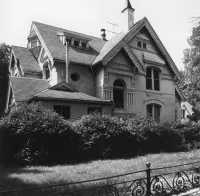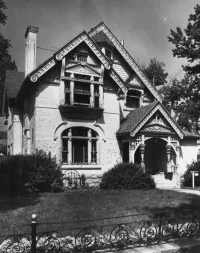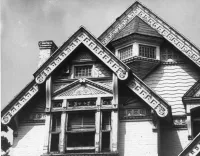Share what you know,
and discover more.
Share what you know,
and discover more.
Oct 25, 1979

-

- Charmaine Bantugan
National Register of Historic Places - Neef House
Statement of Significant: The Neef House is significant for two reasons: (1) it was constructed for an important early day Denver businessman, Frederick W. Neef, and (2) it is an outstanding surviving example of a late 19th century architectural style. A well-educated German, Frederick W. Neef was an important businessman in Denver. he settled in Denver in 1873 and in partnership with his brother purchased the Western Brewery at 733 Eighth Street. They renamed the firm the Neef Brothers Brewery. Frederick subsequently bought out his brother, expanded the plant, and continued operations until the company was dissolved in 1917. Meanwhile, in 1886 he constructed this substantial residence at 2143 Grove Street where he and his family lived for thirty-one years. The Neef House is a fine example of late 19th century architecture in Denver. There are strong indications that the structure was not designed by a local architect, but rather that it was taken directly from an architect's pattern book by a local builder, although investigation did not substantiate this hypothesis. In all events, the Neef House is a well-executed version of the popular Queen Anne/ Eastlake style, probably the finest surviving example in Denver. It clearly demonstrates the Victorian preoccupation with complex volumes and roof forms, and their love for elaborate detail. Of particular note is the east facade which has a strongly sculptured aspect and, in spite of the profusion of elements, displays a rich unified composition which is at once pleasant and dynamic. The original craftsmanship was of a high caliber and survives well despite an obvious lack of maintenance. The present owners intend to maintain the house as a residence and start a complete exterior restoration.
National Register of Historic Places - Neef House
Statement of Significant: The Neef House is significant for two reasons: (1) it was constructed for an important early day Denver businessman, Frederick W. Neef, and (2) it is an outstanding surviving example of a late 19th century architectural style. A well-educated German, Frederick W. Neef was an important businessman in Denver. he settled in Denver in 1873 and in partnership with his brother purchased the Western Brewery at 733 Eighth Street. They renamed the firm the Neef Brothers Brewery. Frederick subsequently bought out his brother, expanded the plant, and continued operations until the company was dissolved in 1917. Meanwhile, in 1886 he constructed this substantial residence at 2143 Grove Street where he and his family lived for thirty-one years. The Neef House is a fine example of late 19th century architecture in Denver. There are strong indications that the structure was not designed by a local architect, but rather that it was taken directly from an architect's pattern book by a local builder, although investigation did not substantiate this hypothesis. In all events, the Neef House is a well-executed version of the popular Queen Anne/ Eastlake style, probably the finest surviving example in Denver. It clearly demonstrates the Victorian preoccupation with complex volumes and roof forms, and their love for elaborate detail. Of particular note is the east facade which has a strongly sculptured aspect and, in spite of the profusion of elements, displays a rich unified composition which is at once pleasant and dynamic. The original craftsmanship was of a high caliber and survives well despite an obvious lack of maintenance. The present owners intend to maintain the house as a residence and start a complete exterior restoration.
Oct 25, 1979
National Register of Historic Places - Neef House
Statement of Significant:The Neef House is significant for two reasons: (1) it was constructed for an important early day Denver businessman, Frederick W. Neef, and (2) it is an outstanding surviving example of a late 19th century architectural style.
A well-educated German, Frederick W. Neef was an important businessman in Denver. he settled in Denver in 1873 and in partnership with his brother purchased the Western Brewery at 733 Eighth Street. They renamed the firm the Neef Brothers Brewery. Frederick subsequently bought out his brother, expanded the plant, and continued operations until the company was dissolved in 1917. Meanwhile, in 1886 he constructed this substantial residence at 2143 Grove Street where he and his family lived for thirty-one years.
The Neef House is a fine example of late 19th century architecture in Denver. There are strong indications that the structure was not designed by a local architect, but rather that it was taken directly from an architect's pattern book by a local builder, although investigation did not substantiate this hypothesis. In all events, the Neef House is a well-executed version of the popular Queen Anne/ Eastlake style, probably the finest surviving example in Denver. It clearly demonstrates the Victorian preoccupation with complex volumes and roof forms, and their love for elaborate detail. Of particular note is the east facade which has a strongly sculptured aspect and, in spite of the profusion of elements, displays a rich unified composition which is at once pleasant and dynamic. The original craftsmanship was of a high caliber and survives well despite an obvious lack of maintenance. The present owners intend to maintain the house as a residence and start a complete exterior restoration.
Posted Date
Jul 31, 2023
Historical Record Date
Oct 25, 1979
Source Name
National Register of Historic Places
Source Website
Delete Story
Are you sure you want to delete this story?












